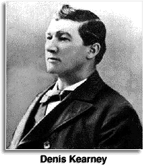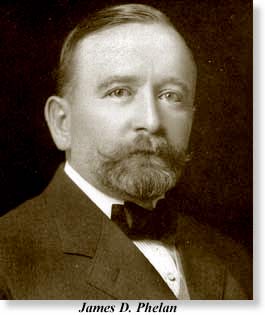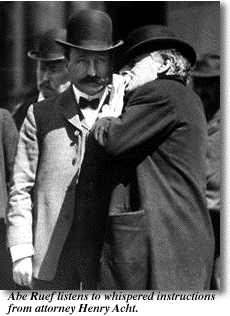|
"Kearney Agitation in California," by Henry George
Biography of Henry George
Biography of Eugene Schmitz
Biography of James D. Phelan |
The first concerted drive by labor in San Francisco was for a shorter work day. In 1860 the work day was usually 12 hours. Laborers struck for a 10-hour day. They were working from 6 a. m. to 6 p. m. spreading sand dumped at the foot of California street by the cars from David Hewes’ steam paddy. According to The Bulletin the laborers “argued that 10 hours a day is enough for any man to sweat.” The men who left the job were paid off. Later, one of the leaders for a shorter work day was General A. M. Winn, first mayor of Sacramento. General Winn, California militia official, had been a carpenter and contractor in Ohio and Mississippi before coming to California in 1849. Having made a fortune in California real estate, he gave money and time to the campaign for an eight-hour day, which had been started by Alexander M. Kenaday San Francisco printer and early president of the Eureka Typographical Union
General Winn led the procession in San Francisco on February 22, 1888, celebrating the passage of California’s eight-hour law. Enforcement of the eight-hour law was complicated by hordes of jobless who moved into San Francisco at the completion of the transcontinental railroad. For several years General Winn, first president of the Mechanics’ State Council, which he and Kenaday organized, provided an employment service for eight-hour men. San Francisco first realized that the idle were not jobless though lack of industry when in March, 1870, a thousand men responded to an advertisement for 100 to clear Yerba Buena Park, the sandy wastes which had once been Yerba Buena Cemetery. The 115 men hired worked themselves out of a job by evening, having cleared away the trees and underbrush.
The park became the meeting place of the jobless, who planned a new world. Watching them, a printer and newspaperman named Henry George concluded that there must be some connection between the vanishing frontier, progress and poverty. Sympathetic to the laboring man, he studied the depression-ridden seventies from the editor’s desk of The Evening Post, which he had founded in 1871. By December, 1875, George had already published a pamphlet on his theories which resulted in the book, “Progress and Poverty,” which ran into more than 2,000,000 copies.
The several thousand citizen members of the pick-handle brigade had been recruited to help police and militia quell sandlot rioters in threatened forays on the Pacific Mail Steamship docks and Chinatown.
Many men suspected Kearney’s motives. Many others responded fiercely to his rabble rousing speeches, written by Chester Hull, a newspaperman with a flair for incendiary phrases. One of the; labor leaders who opposed Kearney, was Frank Roney, Irish born man of wealth who had fought for the Irish Republic before becoming a voluntary exile to America. Now a naturalized citizen, a moulder by trade, Roney gave the same loyalty to labor that he had given the Fenian cause. Roney appeared on the sand lots with Kearney just once. Then, following dramatic warnings of traitors by Kearney, he put his hand on ,the agitator’s shoulder as he told the crowd of 10,000, “If there be one traitor who is ahead of all others it is this man. If you follow him you will rue that day and your party will accomplish nothing.” In Roney’s estimation, Kearney’s Workingman’s Party of California “left its impress for years afterwards in having produced during its brief existence an inferior and more numerous class of political bosses and blacklegs than had been produced in all the preceding history of the city.” Although Roney had a wife and two children who depended on him for livelihood, they stood second to the cause of labor. In his fight to better conditions and wages for seamen he worked from 5 a. m. to “at least 6 p. m.” each day as a moulder, but organized the seamen in his spare time. One of his targets was the “crimps,” the boarding house keepers who had supplied sea captains with shanghaied crews since the days of the gold rush.
Roney’s sense of organization, his determination to cement the ranks of labor into closer and more powerful unity, resulted in the Federal Trades and Labor Council, organized in 1885 with Roney as its first president. He was working at a city job, assistant to the city engineer, and most of the Council business was conducted from the fireroom of the City Hall. When the administration changed and Roney lost his city job, he found himself blacklisted by every foundry in San Francisco. Needing a job to feed his family, he gave up his labor activities and moved to Vallejo.
Labor was bitter when Mayor James D. Phelan sent police to protect strike-breakers. Phelan was the son of a wealthy gold rush banker and financier. The closed shop issue was lost. Some labor leaders, but not all, concluded the only way to prevent a recurrence of Phelan’s action was to elect a new set of city officers. Thus rose the Union Labor party.
When the organizers of the Union Labor party asked Andrew Fureseth, a power in the sailors union and City Front Federation, to take part in planned activities, he said the Union Labor Party was “a sad mistake and likely risen from resentment rather than common sense.” He would have nothing to do with them. The Union Labor leaders then met up with Abraham Ruef who had 18 years before been a starry-eyed reformer, a believer in a better world. That was when he was a brilliant University of California graduate at 19, class of 1883. Ruef crossed the path of labor in 1901. The most prominent man in labor to be interested in the new party was Eugene E. Schmitz, president of the Musician’s Union. Schmitz and Ruef had been friends for 15 years. Ruef and a fortune teller sold Schmitz on the idea of running for mayor.
Ruef slipped in and out of offices, suggesting his “appointment” as attorney for various corporations while his intermediary on the Board of Supervisors shared the loot. Not even the earthquake and fire of April 18, 1906, could shatter the pattern of corruption. After four years of graft prosecutions only Ruef served time in San Quentin. Fureseth, who had scorned the whole idea of a grudge-born Union Labor party years before, carried on in the same devoted, dedicated and tyrannical course to organize labor established by Roney back in the seventies. He worked for better conditions aboard ships, finally saw the La Follette Seamen’s act become law in 1915. By that time labor was rapidly expanding. It was no longer a one man organization even in San Francisco. Fureseth had become a symbol, unrelenting and vigilant. Even when there was tranquillity in labor circles Furuseth refused to relax. “Too much is being written and spoken about peace,” he said in his Norwegian accent. “I never saw peace anywhere in my life except in a graveyard. And it got disturbed there every time anybody died.”
The Call-Bulletin Dolores Waldorf, member of the California Historical Society and one-time editor of the Society of California Pioneers Quarterly, is the author of numerous articles on early California history. She is daughter of the late John Taylor Waldorf, widely known newspaperman of his day, an associate of Fremont Older on the old Bulletin, and who was on the editorial staff of The Call when she first joined The Bulletin’s staff in 1921. She is now The Call-Bulletin women’s club editor. |
 George’s
theories had far less appeal to the average jobless man than those espoused
by Denis Kearney in 1877. Kearney did not coin the phrase, “The Chinese
must go,” but he made the most of it. He was a prosperous. Hayes Valley
drayman when he joined the Committee of Safety and dangled a hickory pick
handle from a leather thong fastened to his wrist.
George’s
theories had far less appeal to the average jobless man than those espoused
by Denis Kearney in 1877. Kearney did not coin the phrase, “The Chinese
must go,” but he made the most of it. He was a prosperous. Hayes Valley
drayman when he joined the Committee of Safety and dangled a hickory pick
handle from a leather thong fastened to his wrist.
 In
1901 the closed shop issue became a matter of violence and bloodshed in
the San Francisco teamsters and waterfront strike.
In
1901 the closed shop issue became a matter of violence and bloodshed in
the San Francisco teamsters and waterfront strike.
 During
most of Eugene Schmitz’ two terms as mayor of San Francisco the willingness
of his administration to be corrupted was equaled only by the willingness
of certain business interests to corrupt it.
During
most of Eugene Schmitz’ two terms as mayor of San Francisco the willingness
of his administration to be corrupted was equaled only by the willingness
of certain business interests to corrupt it.